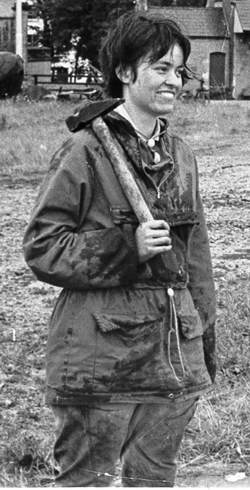 Pioneering carbonate sedimentologist who championed the role of ‘bugs’ in the sedimentary record.
Pioneering carbonate sedimentologist who championed the role of ‘bugs’ in the sedimentary record.
In March of this year, Julia Hubbard died, almost 40 years after I first met her in the bowels of King’s College, London. In 1976 I was visiting my supervisor at Sheffield, when the phone rang. It was Julia enquiring if there were any students who wanted to do a PhD working on coral reefs in Australia. “Here, talk to Julia Hubbard” he said: “She has a NERC funded PhD position and is looking for someone who is handy and can scuba-dive.
Australia
Having accepted the position I was soon on my way to Australia where, for three months Julia and I explored the reefs. I returned to London and with introductions from Julia started to implement the one-paragraph project. Three years later with the PhD completed I realised that Julia had been way ahead of her time. She not only joined Robin Bathurst and Robert Ginsburg as a pioneer of modern comparative sedimentology, but she championed the importance of ‘bugs’ in altering the sedimentary record. She had an infectious enthusiasm.
Julia was born in 1940, the daughter of an architect who was involved in the post-war reconstruction of the Middle East. As a consequence, a great deal of her childhood was spent in this region. According to her brother she developed a late interest in geology and after taking additional courses, and was accepted to Bedford College, London.
Graduate work on the Carboniferous reefs around Sligo, NW Ireland followed. In 1966 she accepted a lecturer position at King’s College. At that time she could really be described as a pioneer in the field, being one of only two women geologists at the University of London.
At King’s her research shifted from ancient to modern, working on reefs in Australia, Africa and the Caribbean. In addition to myself, she mentored several other graduate students, some with unexpected career results. Alistair Crame, currently at the British Antarctic Survey, was joint student with the Natural History Museum and worked on the Pleistocene reefs of the Kenyan coast. Derek Kinchington completed his PhD on the calcification of modern cold-water corals using biological techniques that he subsequently employed in viral research. Her final student, who was working on microbial mechanisms of calcification, never completed her dissertation.
Rationalisation
As a result of the unfortunate ‘rationalisation’ of geology departments in the UK, the Department at King’s College was amalgamated with several others in London and relocated to Royal Holloway. Julia Hubbard, along with her colleague Jake Hancock, refused to move. Julia received only limited support for her work after this - although she continued to attend meetings related to coral reefs, both locally and internationally.
Many acquaintances will have different recollections of Julia. Some remember her as someone who was difficult to understand, others remember an intellect way ahead of her time. I remember a kind and caring individual who was a combination of both of these, and someone whose academic record underestimates her contribution towards Modern Comparative Sedimentology.
Peter Swart